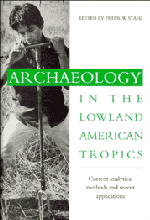Book contents
- Frontmatter
- Contents
- List of figures
- List of tables
- List of contributors
- Introduction
- 1 Archaeological survey and site discovery in the forested neotropics
- 2 The archaeology of community organization in the tropical lowlands: a case study from Puerto Rico
- 3 Archaeological methods for the study of ancient landscapes of the Llanos de Mojos in the Bolivian Amazon
- 4 Searching for environmental stress: climatic and anthropogenic influences on the landscape of Colombia
- 5 “Doing” paleoethnobotany in the tropical lowlands: adaptation and innovation in methodology
- 6 Plant microfossils and their application in the New World tropics
- 7 Differential preservation histories affecting the mammalian zooarchaeological record from the forested neotropical lowlands
- 8 Biological research with archaeologically recovered human remains from Ecuador: methodological issues
- 9 Interpreting dietary maize from bone stable isotopes in the American tropics: the state of the art
- 10 From potsherds to pots: a first step in constructing cultural context from tropical forest archaeology
- 11 Returning to Pueblo Viejo: history and archaeology of the Chachi (Ecuador)
- References
- Index
1 - Archaeological survey and site discovery in the forested neotropics
Published online by Cambridge University Press: 23 November 2009
- Frontmatter
- Contents
- List of figures
- List of tables
- List of contributors
- Introduction
- 1 Archaeological survey and site discovery in the forested neotropics
- 2 The archaeology of community organization in the tropical lowlands: a case study from Puerto Rico
- 3 Archaeological methods for the study of ancient landscapes of the Llanos de Mojos in the Bolivian Amazon
- 4 Searching for environmental stress: climatic and anthropogenic influences on the landscape of Colombia
- 5 “Doing” paleoethnobotany in the tropical lowlands: adaptation and innovation in methodology
- 6 Plant microfossils and their application in the New World tropics
- 7 Differential preservation histories affecting the mammalian zooarchaeological record from the forested neotropical lowlands
- 8 Biological research with archaeologically recovered human remains from Ecuador: methodological issues
- 9 Interpreting dietary maize from bone stable isotopes in the American tropics: the state of the art
- 10 From potsherds to pots: a first step in constructing cultural context from tropical forest archaeology
- 11 Returning to Pueblo Viejo: history and archaeology of the Chachi (Ecuador)
- References
- Index
Summary
Until recent years, archaeologists seldom carried out large-scale surveys in regions having poor visibility and accessibility. Survey in such areas requires a variety of heroic and methodologically unlovely techniques …, such as periodic shovel testing and use of local informants, to simply make site discovery possible (Schiffer 1987: 350).
While the preceding statement is true of numerous areas in New World archaeology, the dual problems of low surface visibility and limited accessibility are probably nowhere greater than in the tropical lowlands of South America, particularly Amazonia. These problems, combined with the sheer immensity of the area and small number of archaeologists working there, have led to widely conflicting interpretations of the archaeological record, not to mention opposing reconstructions of macro-regional prehistories (Gibbons 1990; Roosevelt 1991). In spite of these differences, all archaeologists working in this area have had to confront the severe logistical constraints and preservation biases imposed by the humid tropical environment, and in so doing, have been forced to employ “methodologically unlovely techniques” of one kind or another.
My purpose in this chapter is not to enter into this protracted debate on Amazonian prehistory. Instead, I explore certain methodological themes relating to archaeological survey and site discovery in the forested tropics of lowland South America, using as my point of departure Donald Lathrap's seminal article entitled “Aboriginal Occupation and Changes in River Channel on the Central Ucayali, Peru” (1968a).
- Type
- Chapter
- Information
- Archaeology in the Lowland American TropicsCurrent Analytical Methods and Applications, pp. 7 - 41Publisher: Cambridge University PressPrint publication year: 1995
- 3
- Cited by



